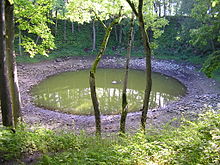Kaali crater




Kaali is a small group of 9 meteorite craters on Saaremaa, Estonia.
The largest of the craters measures 110 meters in diameter and contains a small lake (known as Kaali järv (Lake Kaali). The meteor cluster had an impact velocity of 10-20 km/s and a mass of 20-80 tons. At the altitude of 5-10 km the meteor broke into pieces. The largest fragment produced the main crater with a depth of 22 m. Eight smaller craters with diameters ranging from 12 to 40 m and depths varying from 1 to 4 m are all within 1 kilometer of the main crater.
The explosion that caused the craters is estimated to have happened 660 ± 85 B.C. (Holocene). The energy of the impact (about 80 TJ (20 kilotons of TNT), comparable with the Hiroshima bomb) burned forests within a radius of 6 km.[1] It has been speculated that the event played a part in the mythology of the region. It was known as a "sacred lake", and there is archaeological evidence that it was a place of ritual sacrifices for many centuries. The lake was surrounded by a wall during the early Iron Age. The length of the wall was about 470 meters, its width around 2.5 meters and its height to two meters.
Finnish mythology has stories that may describe happenings of Kaali, one of them in runes 47, 48 and 49 of the Kalevala epic. Louhi, the evil wizard steals the Sun and fire from people, causing total darkness. Ukko, the god of sky orders a new Sun to be made from a sparkle. The virgin of the air starts to make a new Sun, but the sparkle drops from the sky and hits the ground. This spark goes to an "Aluen" or "Kalevan"[2] lake and causes its water to rise. Finnish heroes see the ball of fire falling somewhere "behind the Neva river" (the direction of Estonia from Karelia). The heroes head that direction to seek fire, and they finally gather flames from a forest fire.
According to a theory first proposed by Lennart Meri, it is possible that Saaremaa was the legendary Thule island, first mentioned by ancient Greek geographer Pytheas, whereas the name "Thule" could have been connected to the Finnic word tule ("(of) fire") and the folklore of Estonia, which depicts the birth of the crater lake in Kaali. Kaali was considered the place where "The sun went to rest."[2]
Asteroid 4227 Kaali is named after it.
External links
- Earth Impact Database
- Kaali crater home page
- About Kaali crater on the official Saaremaa website
- Photos of the Kaali crater
References
- ^ Siim Veski, Atko Heinsalu, Kalle Kirsimäe, Anneli Poska, Leili Saarse (2001). "Ecological catastrophe in connection with the impact of the Kaali meteorite about 800–400 B.C. on the island of Saaremaa, Estonia" (PDF). Meteoritics & Planetary Science. 36 (3): 1367–1375.
{{cite journal}}: CS1 maint: multiple names: authors list (link) - ^ a b Lennart Meri (1976). Hõbevalge (Silverwhite). Tallinn, Estonia: Eesti Raamat.
{{cite book}}: Check date values in:|year=(help); Cite has empty unknown parameter:|coauthors=(help)
- Tiirmaa, R. (1992). "Kaali Craters of Estonia and Their Meteoritic Material". Meteoritics. 27 (3): 297.
- Anto Raukas, J.-M. Punning, T. Moora, Ü. Kestlane, A. Kraut (2005). "The Structure and Age of the Kaali Main Crater, Island of Saaremaa, Estonia". Impact Studies (2): 341–355. doi:10.1007/3-540-27548-7_13.
{{cite journal}}: CS1 maint: multiple names: authors list (link)
